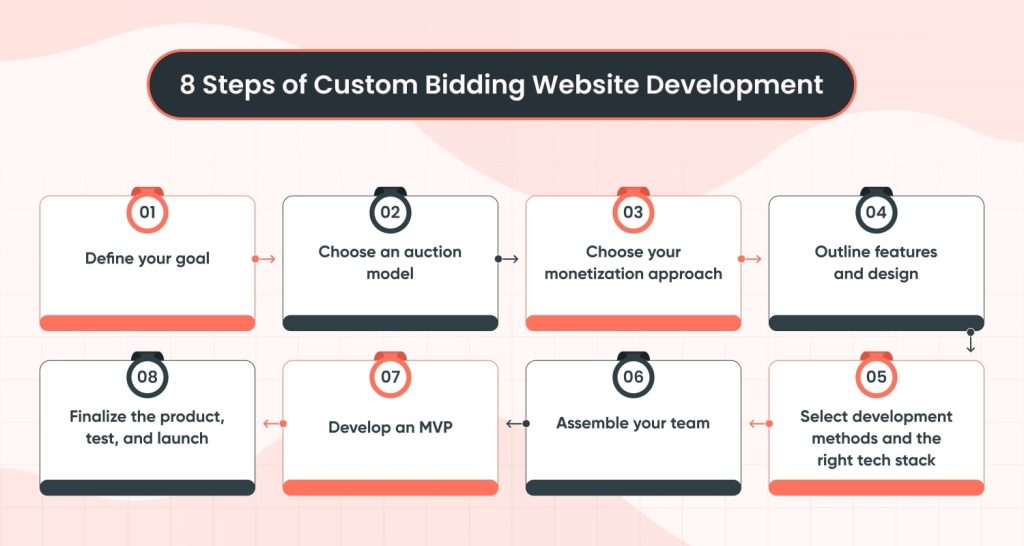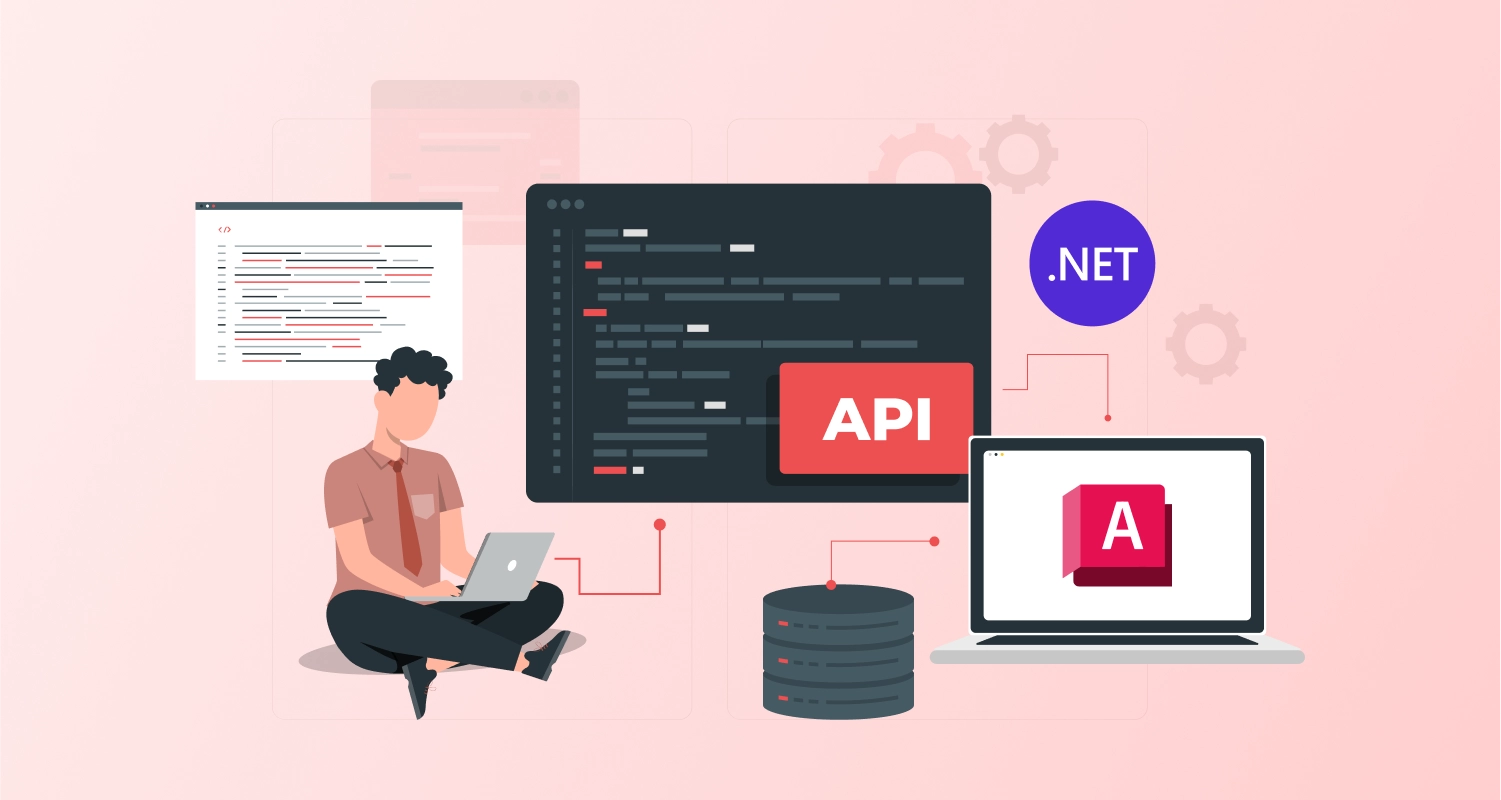A penny auction is a kind of auction in which a product or service is offered for sale at a meager starting price, bidders enter their bids in increments of a predetermined size, and you have to pay for each request that you make.
Winner status is awarded to the contestant who placed the highest final bid. This post will walk you through the steps of launching your very own penny auction website and show you how to monetize it when you hire a dedicated developer.
Penny Auction Website Business Model
The number of bids and duration of a penny auction defines an item’s price. Users bid a few cents on a “penny auction” item. A request restarts the clock and raises the object’s price by a fraction (also usually a few cents). The auction will end after a specified period if there are no more offers, and the successful bidder will be notified of the final price.
Penny auction websites thrive on pre-purchased bids. Auction bid packages may cost anything from a few dollars to several hundred dollars. The website generates money by selling bid packages and other fees (such as a membership fee or a fee for using certain features of the site).
Target audience and Domain of the penny auction
Since the things available for bid at penny auctions may include everything from electronics and home items to gift cards and vacation packages, they tend to appeal to a wide variety of online customers. However, certain penny auction websites may cater to a more particular clientele by specializing in high-end items or collectibles.
Users that appreciate the excitement and thrill of bidding and are prepared to take a risk to possibly obtain a reasonable price on an item may find themselves attracted to penny auctions.
However, not all shoppers should join up for penny auctions because of their potential complexity and high entry costs. Consumers should weigh the benefits and drawbacks of participating in penny auctions before deciding whether they will use this kind of online bidding.
Must-have features of bidding software
Online auctions, such as penny auctions, rely on a special kind of software called bidding software. The following are some of the most important aspects of any bidding software:
- The software’s interface should be straightforward, with simple steps for making bids and natural settings for managing auctions.
- The program should offer real-time information on the progress of auctions, including the current bid amount, the number of bids put, and the length of time left in the auction.
- Fraud and hacking protection are of paramount importance. Hence the program should have robust security features like encryption and secure login systems.
- The program should work on mobile devices so that users may participate in auctions even if they are away from their desks.
- The program must allow customers to alter auction parameters such as beginning price, increment amount, and auction duration.
- The program should be able to connect with several payment gateways, so that buyers and sellers may send and receive funds without any hassle.
- If the program is aimed at a worldwide audience, it should be available in some different languages so that everyone may use it.
- The program should be able to scale up to accommodate a growing number of customers and auctions without slowing down or crashing.
The essential functions of bidding software will, as a whole, be determined by the requirements of the auction website and the aims of its users.
Eight Steps of Custom Bidding Website Development

Let’s learn how to build a penny auction website-
1. Define your goal
The first step in any endeavor is to define the objective; creating a bespoke bidding website is no different. If the website is to be designed to satisfy the unique demands and goals of the company or organization, then it must have a well-defined and explicit aim to serve as a beacon for the development process.
A custom bidding website might have the following aims:
- To make it easier for anyone to hold online auctions for a particular item or Website development services.
- To facilitate the exchange of goods and services between users, a platform must be made available.
- To build a group of people with the same passion or interest and engage with one another.
- To spread the word about a product or service and raise its profile.
- If you want your website to be created and built to match the unique demands and objectives of your web development company or organization, you need to be very clear and explicit when expressing your purpose.
2. Choose an auction model
A bespoke bidding website may use any number of auction models, each with its own idiosyncrasies and restrictions. Which auction model is best for your website depends on your organization’s or company’s unique aims and demands, as well as the preferences of your intended audience.
Some popular types of auctions are described below:
- For items being auctioned off in English auctions, often called “forward auctions,” buyers try to outbid one another for the chance to win the thing. When no one else makes a more excellent offer, the auction closes, and the object is sold to the highest bidder.
- The auctioneer in a Dutch auction, often called a “reverse auction,” will set a high opening bid and work down to a price at which someone is prepared to make a purchase. In an auction, the highest bidder is the one who accepts the current price.
- Bidders in a sealed-bid auction, often called a “first-price sealed-bid auction,” do not know the prices at which other bidders have placed their offers. All auctions end with the highest bidder receiving the item at the stated price.
- Penny auctions websites are auctions where bids start at a meager amount and gradually climb as more people submit requests. After a long time has passed with no other offers, the auction will conclude and the winning bidder will be charged the final price.
Other forms of auction models exist as well, and the one that’s ideal for your bespoke auction website will rely on them. To find the solution that is most suited to your company’s needs, it may be helpful to investigate and evaluate many alternatives.
3. Choose your monetization approach
Monetization, or the practice of making money using an online medium, is a term used to describe how such mediums are supported financially. To achieve success with a bespoke auction site, it’s vital to choose a monetization strategy that fits your objectives and those of your intended users.
Consider the following typical methods of monetization when designing your own bidding website:
- One popular method used to generate revenue for auction websites is to require users to purchase “bid packages” before they can take part in auctions. The website generates income from the selling of these bid bundles.
- You may also implement membership fees for users who want to have access to additional services or take part in auctions on your website.
- Selling advertising space to companies and organizations who desire exposure to your site’s visitors is another way to earn money.
- Earning money via promoting items or services offered by third-party retailers is possible through affiliate marketing.
- Some online auction sites need a paid membership to access the full range of services they provide.
- Fees for completed auctions or other transactions are another way to generate income from your website.
As with any business decision, the best way to monetize your custom bidding website will rely on the unique demands of your operation and the people who frequent it. Try out a few strategies to find the best work for your company or group.
4. Outline features and design
Bidding systems include various features and design concerns. Bidding systems often have:
- Bidding requires user registration and login.
- Item listings: The system should let users post objects for auction, including condition, beginning price, and ending date.
- Bidding: The system should monitor and show the highest bid for products.
- Notification and alerts: The system should warn users when they are outbid or when an auction is finishing shortly.
- Payment processing: The system should let users pay for won products, either via a built-in payment gateway or by giving offline payment instructions.
User experience and a straightforward, intuitive interface are crucial when designing a system. This may include utilizing plain language, offering visual aids and instruction, and testing the interface with users to gain feedback and suggest areas for improvement. These characteristics and user experience may help you construct a successful bidding system.
5. Select development methods and the right tech stack
Project needs and goals determine the best development methodology and tools. Are you selecting a technology stack? Prioritize these.
- List your project requirements. Web or mobile app developer needed? A simple or complicated program? Will information or visitors be abundant? These factors are vital when choosing a development plan and technology.
- How well-versed are your developers? Choose a technology stack and hire web developers your team is acquainted with.
- Budget: How much will this project cost? Cost is critical when choosing development methods and technology stacks.
- Is the project time-sensitive? Different development methods and technology stacks may work depending on project time limitations.
- How will you update the app after launch? When picking a tech stack, consider maintenance ease.
6. Assemble your team
Putting together a team to work on a project is crucial. Some advice on how to put together a winning team:
- To ensure that everyone in the team understands their place and how they may best contribute to the project, it is vital to establish their specific roles and responsibilities.
- Pick the appropriate people: Pick team members that bring something unique to the table in terms of expertise, prior experience, and character traits.
- Clearly express yourself: Put in place efficient methods of communication among team members and make sure everyone is on the same page.
- Promote teamwork: Insist that everyone on the team pitch in and helps one another out.
- Ensure team members have access to training, tools, and assistance from project managers, as well as other resources necessary for success.
Building a powerful and efficient team that is ready to take on your project is possible if you follow these guidelines.
7. Develop an MVP
A minimal viable product (MVP) is a product version with only enough functionality to attract and retain consumers. Instead of spending a lot of time and money on creating a complete understanding of a product before you know whether there’s a market for it, you can test the waters with a minimum viable product and get feedback from potential customers.
Methods for creating a Minimum Viable Product:
- Learn to spot the essentials: Find out what functions are crucial for the product’s purpose. All of these functions are part of the minimum viable product.
- Make a list of the most crucial traits and rank them in order of priority.
- Create the Minimum Viable Product (MVP) by focusing on the most critical features identified in the prioritization process. Getting input and testing the market as fast as possible necessitates a streamlined version of the final product.
- Iterate and get comments on the first step is to get the MVP out there and receive consumer feedback. Incorporate this criticism into future iterations of the MVP to fix any issues or shortcomings you may have missed.
- Improve and iterate based on consumer input from the MVP to get to a state where the product fully satisfies their wants and expectations.
By adhering to these guidelines, you may create a minimum viable product (MVP) and rapidly test the market, gaining insights that will inform the creation of the final product.
8. Finalize the product, test, and launch
The next stage is to complete the product and get it ready for launch once you have produced and tested your MVP. The procedure is as follows:
- Put the finishing touches on the product by incorporating any suggestions or adjustments made after releasing the MVP. This may include changing existing features, introducing new ones, or enhancing the current ones to provide a better user experience.
- Put the product through its paces and ensure it’s launch-ready by giving it a thorough test run. This might entail a combination of human and automated testing to ensure that all possible use cases are covered.
- Once you have completed development and testing of the product, it is ready to be released to the public. It’s possible that the product will be introduced to a select set of people at first, with a more significant release to follow.
- Check-in on the product to see whether it’s doing what it’s supposed to be doing for users, and fix anything you find once it’s out into the wild. Updating and maintaining a product regularly helps it work smoothly, keeps it current, and keeps it helpful to its audience.
If you follow these guidelines, you should be able to introduce a marketable product that appeals to buyers.

How we developed a bidding Website?
Several stages create a bidding website, such as:
- Lay down the parameters of the website: Site objectives, features, and functioning must all be spelled out in detail. You may then use this information to define the parameters of the project and anticipate any difficulties.
- Gather a crew: Collect a group of experts in web development company , design, and related fields to work on the website’s creation.
- Decide on a technique for growth: Pick a process for project development to follow, such as agile or waterfall.
- Select a technology stack that best fits your needs. Choose a set of software programs from which to construct the website; examples include LAMP and MEAN.
- Create mockups and wireframes to outline the website’s structure and features.
- Construct the website: using the selected technology stack and development approach, construct the website and test and iterate as needed to ensure it satisfies the project’s needs and goals.
- The website should be rigorously tested to guarantee its readiness for launch and stability, and then released to the public. When you’re satisfied with how the site performs in testing, you may make it available to the general public.
If you stick to these guidelines, you should be able to create a bidding platform that your consumers will like using.
The Costs of Bidding System Development
The resources needed to design a bidding system, as well as the complexity of the system and the number of features and functions it must have, will affect the total cost of development.
The cost of build an auction website may be affected by the following:
- Costs might vary depending on which development approach is used. Thus it’s important to weigh options like agile and waterfall.
- What languages, frameworks, and tools were utilized to create the system may all affect the budget.
- Size and competence of the development team might also have an impact on the final price tag. This is because more seasoned programmers will likely want greater compensation for their ecommerce website development services.
- The length of the project may also play a role in the final price tag by increasing the amount of time and effort needed to complete the task.
Cost estimates for establishing a bidding system are notoriously imprecise without essential details about those criteria and aims. To guarantee the project’s success, however, a thorough financial strategy and budget must be developed in advance.
Conclusion
Building an effective and user-friendly penny bidding site may be a challenging and time-consuming process, but it is feasible with proper preparation and the right team and resources.
Successful websites are the result of meticulous planning that takes into account the project’s goals and constraints, selects an appropriate development strategy and technology stack, and prioritizes the needs of site visitors throughout the design phase.
Frequently Asked Questions
What is a penny auction website?
Penny auction sites allow users to bid in tiny increments, usually $0.01. A bid resets the auction timer to a predefined time and raises the item’s price by the bid amount. The auction continues until the timer runs out or no more bids are entered, at which point the highest bidder wins.
Penny auction sites provide high-value products at affordable costs since the final selling price is usually far lower than the retail value.
How do bidding sites work?
Online auction sites, often known as bidding sites, let consumers bid on auctioned products. Bidding site users must register and establish an account to bid. An object is auctioned with a beginning price and minimum bid increment (the minimum amount by which the bid can be increased). Each request increases the current bid price by the minimum bid increment.
How do I create an online art auction?
Steps to launch an online art auction:
Choose your auction type: You may arrange a specific auction, where bidders battle to win the item, or a fixed-price auction, where purchasers can buy the item without bidding.
Choose a platform: eBay, LiveAuctioneers, and Invaluable are all online art auction sites. To pick the best platform, evaluate costs and features.
Create your account and auction: Follow the platform’s instructions. The artwork’s description, photos, and provenance or authenticity documentation must be provided. Set the auction’s starting price, finish time, and other parameters.
Promote your auction using social media, email, and other methods. Clarify the artwork and auction procedure.
Monitor the auction and answer buyer queries. Contact the auction winner to arrange payment and delivery. Follow online auction laws.
How do penny auction sites make their money?
Penny auction sites generate money through auction fees. These costs may include:
1. Bid fees: Some penny auction sites charge for bids. Site-specific prices range from a few cents to a few dollars.
2. Membership costs: Some penny auction sites demand monthly or yearly fees to access the site and its auctions.
3. Penny auction sites may charge sellers to list their things.
4. Buyer’s premium: Some penny auction sites add a buyer’s premium to the selling price.
Penny auction sites may also profit from advertising and collaborations. Some areas profit from unclaimed or unsold products. To minimize surprises, study and understand any penny auction site’s fees and charges.


![How to Create a Website For Penny Auctions? [Step-by-Step Guide]](https://blog.cdn.cmarix.com/blog/wp-content/themes/cmarixinternal/public/images/no-image.png)




